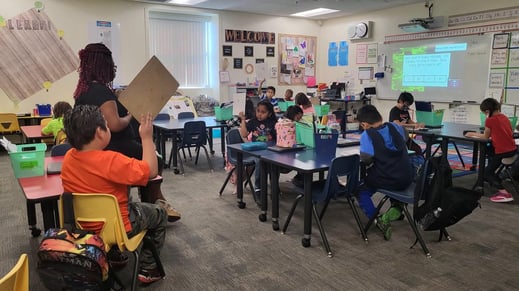
Teachstone recently sat down with Janea Menicucci, Rebecca Thomas, Jennifer Armstrong, Alexis Rel, Cammie LePlatt, and Candise Forgue, a group of educators in New Mexico. During this discussion, they were kind enough to share the purpose of the Universal Design for Learning (UDL) framework and how they use it to enhance their learning environments and improve student outcomes.
Many aspects of UDL align with the principles of the CLASS® tool, making it easy to use both frameworks to support the growth and development of children, including those with special needs.
What Is UDL?
UDL is an evidence-based framework that views learning through the lens of children with special needs. Introduced in the 1990s, it encourages educators to analyze all aspects of classroom dynamics such as instructional strategies and materials and be more purposeful in engaging all students based on their strengths and needs. UDL is available through CAST, a nonprofit educational research and development organization.
The driving force of UDL is experience. It links learning efforts to real-life situations and children’s backgrounds and abilities. Educators who use UDL do not rely on standard scenarios or traditional learning models. Instead, they view each child as an individual with their own set of strengths. When learning is crafted around their unique needs, children are more engaged.
“UDL is based on what we know about the brain,” Janea said, “with the current iteration made up of three principles. The first, engagement, is based upon the affective network of the brain, or how to encourage interest and motivation. The second, representation, is based on the recognition network, or how to present content in various ways. And the last principle, action and expression, is based on the strategic network, or how children express or show what they have learned.”
It comprises nine guidelines and 33 checkpoints in a color-coded grid for different learning themes. Hooks are used to activate children’s senses according to their individual strengths and learning styles.
This individualization aligns to the CLASS tool’s dimension, Educator Sensitivity, as educators use their awareness of children’s unique qualities to provide support. There are elements of the Instructional Learning Formats dimension, which encourages the use of various teaching strategies and modalities to capture children’s interests and promote engagement.
Cami works with high school students and noted the value of the UDL framework for that age group as well. “When I talk to them,” she said, “I explain that there are pathways in the brain, and they can access them to understand information. It’s just a matter of finding the correct pathway to facilitate engagement.”
How Is UDL Implemented?
The UDL framework uses various engagement means to reach children with different learning styles. Adopting UDL helps students to be more attentive during instruction which aligns with children’s interest and focused attention in Instructional Learning Formats (within CLASS). Such efforts lead to sustained learning and increased emotional, behavioral, and social growth. Educators can further support this sustained learning with individualized feedback strategies outlined in the CLASS dimension, Quality of Feedback.
UDL is a hands-on approach to learning that helps children find joy and meaning in their experiences. Concepts like the Jagged Learning Profile promote flexible learning environments that give children a voice and work with their strengths. Used this way, UDL offers an innovative way for educators to use action and expression as part of the learning experience. “UDL is necessary for our students with special needs,” Jennifer noted, “but you’ll find it’s also good for other students, too.”
The CLASS dimensions of Positive Climate and Regard for Child Perspectives address these ideas, encouraging educators and children to find enjoyment in the classroom and promoting educator flexibility to allow for children’s diverse forms of expression.
Sample activities within the UDL framework include sensory bins that bring learning concepts to life and tic-tac-toe boards that showcase knowledge of specific topics. Changes to the environment, like flexible seating instead of a traditional classroom setting, also aid in learning. Shifting educators from the front of the classroom to moving around, presents more opportunities for interactivity and collaboration. Learning resonates with each child as they deepen their knowledge through choice and creativity.
In the CLASS tool, Concept Development supports children to analyze, reason, and use their creativity to generate their own ideas and products. A more flexible set up and educators moving around the classroom also offer more opportunities for educators to provide individualized feedback for students (Regard for Child Perspectives, Quality of Feedback).
“When you know the student’s strengths, you get to provide options and sit back and just help monitor progress,” Alexis said.
Acknowledging Individual Superpowers
Each child’s individual needs may be overlooked when working with groups of children to meet educational goals. By using the UDL framework to view students according to their unique abilities, educators can acknowledge their individual superpowers. Janea shared an example of an autistic student mislabeled nonverbal because he needed to fully take in his surroundings before responding to questions. Using UDL, the educator recognized art as this student’s superpower and allowed him to operate from that space. Once he tapped into his artistic abilities to communicate, his engagement increased.
Seeing UDL as a framework for every learner means accepting that we learn differently. Some students are visual or auditory learners, while others require hands-on experience. “I love working with students with special needs and those who find it difficult to problem solve,” Camila shared. “I get to find unique ways for them to express themselves, like using art or music.”
When you tap into a student’s distinct learning ability, you encourage their superpowers. Social learners, for example, will excel when they talk through concepts, while artistic learners need to draw or build things. Some students might do better creating a video or sharing their stories verbally versus writing them down.
As outlined in Educator Sensitivity within CLASS, this approach centers around meeting the full range of needs that children have and responding to them in a way that makes them feel comfortable enough to participate and take risks. Understanding the difference in student needs as educators ensures a more engaging and interactive learning environment.
UDL in Practice
For many students, sitting at a desk with limited exploration is detrimental to their learning. Activities like musical chairs benefit the individual while also meeting curriculum goals. With this activity, students play musical chairs while carrying notebooks. Instead of taking a chair away each time the music stops, the children use this time to share something they’ve learned. For students who need repetition or visual cues to learn, this exercise lets them gather the information they need. Afterward, educator-led discussions reinforce what they have learned.
Such discussions are key features in the dimension of Concept Development of the CLASS tool. Providing children with opportunities to generate their own thoughts, and questions and participate in open-ended activities that stimulate their thinking. Educators then help facilitate the process of integrating experiences into new understandings.
Some students need to move to engage fully. The group shared a story about one student who couldn’t respond to a math question until he returned from recess. The movement was mandatory for his engagement. Using the UDL framework, his educator shifted from traditional learning strategies to creative ways to work physical activity into the classroom. “This shift created learning that was purposeful and motivated this student by accessing his strength in art,” Janea shared.
Another example of using UDL involved a group of young boys who struggled to stay focused when learning about volume. These students were moved outside, where they captured snow in plastic containers shaped like cones, spheres, and prisms. The physical activity stimulated their senses and led to discussions of snow turning into water and its impact on volume. When polled years later, one boy still recalled how much fun he had from that exercise.
“It’s important to help students create real-life scenarios,” Janea said. “To think how what they are learning affects them, and why.” Grounding classroom concepts in real-world application is a component of the CLASS dimension Concept Development, and helps ensure that learning is relevant and retained.
Creativity is essential, whether through art, music, or written expression. One educator allowed her students to share their knowledge of historical figures through a puppet show instead of a final exam. This activity revealed an in-depth mastery of the content traditional testing methods would have missed. Another creative example shared by the group involved letting students stack tiny pictures of Janea against a large tree to estimate height.
Creativity is also key in the CLASS dimensions Regard for Child Perspectives and Concept Development. Educators allow children the space to share their ideas and points of view in new and original ways thus building on their prior knowledge and solidifying understanding.
All of these examples, while focused on specific students, demonstrate ways that educators can transform the learning environment and interactions to meet the needs of all students. One key benefit of UDL is that everyone in the classroom can benefit from this approach.
UDL and CLASS
The UDL framework promotes socialization and the empowerment of individual student learning pathways. Its motto is “all means all” because it’s not only for children with special needs. Other students and even adults can benefit from educators who instruct with intentionality and authenticity. Using real-life scenarios and one’s strengths to guide learning encourages deeper understanding and retention.
Educators can use UDL to liven their classrooms while promoting activities that meet individual student needs. This could be through highly creative means, simple activities like Play-Doh for hands-on experience, sharing stories into a microphone for auditory learners, or dance activities for children needing movement to learn. The goal is to promote engagement while keeping a child’s individual strengths in mind. “UDL is definitely home for all of us,” Candise said. “We love what we do.”
UDL can align with Teachstone’s CLASS tool, which seeks to improve learning by focusing on meaningful child-educator interactions. For more information about CLASS, visit https://teachstone.com/class/. To learn more about the New Mexico UDL and download a lesson sample, visit https://sites.google.com/crecnm.com/nmudl/home.
ABOUT THE AUTHORS
 Vicki Kintner-Duffy - As a Senior Research and Evaluation Specialist, Vicki works with the team to ensure a solid research base behind all of Teachstone's products and services, as well as uses data to support innovation and improvement. When she isn’t at the office, Vicki enjoys hanging out with her daughters and hubby, exploring Memphis (blues, anyone?), and going to dance or yoga class.
Vicki Kintner-Duffy - As a Senior Research and Evaluation Specialist, Vicki works with the team to ensure a solid research base behind all of Teachstone's products and services, as well as uses data to support innovation and improvement. When she isn’t at the office, Vicki enjoys hanging out with her daughters and hubby, exploring Memphis (blues, anyone?), and going to dance or yoga class.
 Emily Rouge - Emily is a part of the Research and Evaluation team where she manages the development of CLASS crosswalks and supports the generation and dissemination of data on the effectiveness of Teachstone's products and services. Emily currently lives in Indianapolis where she enjoys working on home improvement projects, "porching" with friends, and reading.
Emily Rouge - Emily is a part of the Research and Evaluation team where she manages the development of CLASS crosswalks and supports the generation and dissemination of data on the effectiveness of Teachstone's products and services. Emily currently lives in Indianapolis where she enjoys working on home improvement projects, "porching" with friends, and reading.
